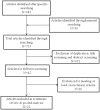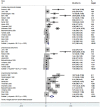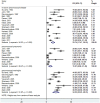Burden of invasive pneumococcal disease in children aged 1 month to 12 years living in South Asia: a systematic review
- PMID: 24798424
- PMCID: PMC4010478
- DOI: 10.1371/journal.pone.0096282
Burden of invasive pneumococcal disease in children aged 1 month to 12 years living in South Asia: a systematic review
Abstract
Objective: The primary objective was to estimate the burden of invasive pneumococcal disease (IPD) in children aged 1 month to 12 years in South Asian countries.
Methods: We searched three electronic databases (PubMed, Embase and the Cochrane Library) using a comprehensive search strategy, we manually searched published databases (Index Medicus and Current Contents) and we also searched the bibliographies of the included studies and retrieved reviews. The searches were current through June 2013. Eligible studies (community-based and hospital-based) were pooled and a separate analysis for India was also completed. A meta-regression analysis and heterogeneity analysis were performed. The protocol was registered with PROSPERO registration number CRD42013004483.
Results: A total of 22 studies surveying 36,714 children were included in the systematic review. Hospital-based prospective studies from South Asia showed that 3.57% of children had IPD, and 15% of all bacterial pneumonia cases were due to Streptococcus pneumoniae. Indian studies showed that the incidence of IPD was 10.58% in children admitted to hospitals with suspected invasive bacterial diseases, and 24% of all bacterial pneumonia cases were due to S. pneumonia. Population-based studies from South Asian countries showed that 12.8% of confirmed invasive bacterial diseases were caused by S. pneumonia whereas retrospective hospital-based studies showed that 28% of invasive bacterial diseases were due to S. pneumoniae. Meta-regression showed that there was a significant influence of the antigen testing method for diagnosing IPD on IPD prevalence.
Conclusion: S. pneumoniae is responsible for a substantial bacterial disease burden in children of South Asian countries including India despite the presence of high heterogeneity in this meta-analysis. Treatment guidelines must be formulated, and preventive measures like vaccines must also be considered.
Conflict of interest statement
Figures











Similar articles
-
Immunogenicity and seroefficacy of pneumococcal conjugate vaccines: a systematic review and network meta-analysis.Health Technol Assess. 2024 Jul;28(34):1-109. doi: 10.3310/YWHA3079. Health Technol Assess. 2024. PMID: 39046101 Free PMC article.
-
Pneumococcal conjugate vaccines for preventing vaccine-type invasive pneumococcal disease and pneumonia with consolidation on x-ray in children under two years of age.Cochrane Database Syst Rev. 2004 Oct 18;(4):CD004977. doi: 10.1002/14651858.CD004977. Cochrane Database Syst Rev. 2004. Update in: Cochrane Database Syst Rev. 2009 Oct 07;(4):CD004977. doi: 10.1002/14651858.CD004977.pub2. PMID: 15495133 Updated.
-
Signs and symptoms to determine if a patient presenting in primary care or hospital outpatient settings has COVID-19.Cochrane Database Syst Rev. 2022 May 20;5(5):CD013665. doi: 10.1002/14651858.CD013665.pub3. Cochrane Database Syst Rev. 2022. PMID: 35593186 Free PMC article.
-
Falls prevention interventions for community-dwelling older adults: systematic review and meta-analysis of benefits, harms, and patient values and preferences.Syst Rev. 2024 Nov 26;13(1):289. doi: 10.1186/s13643-024-02681-3. Syst Rev. 2024. PMID: 39593159 Free PMC article.
-
Systemic pharmacological treatments for chronic plaque psoriasis: a network meta-analysis.Cochrane Database Syst Rev. 2021 Apr 19;4(4):CD011535. doi: 10.1002/14651858.CD011535.pub4. Cochrane Database Syst Rev. 2021. Update in: Cochrane Database Syst Rev. 2022 May 23;5:CD011535. doi: 10.1002/14651858.CD011535.pub5. PMID: 33871055 Free PMC article. Updated.
Cited by
-
Burden of bacterial meningitis in India: Preliminary data from a hospital based sentinel surveillance network.PLoS One. 2018 May 16;13(5):e0197198. doi: 10.1371/journal.pone.0197198. eCollection 2018. PLoS One. 2018. PMID: 29768458 Free PMC article. Clinical Trial.
-
Etiology of community acquired pneumonia among children in India: prospective, cohort study.J Glob Health. 2015 Dec;5(2):050418. doi: 10.7189/jogh.05.020418. J Glob Health. 2015. PMID: 26528392 Free PMC article.
-
Chronicling the Journey of Pneumococcal Conjugate Vaccine Introduction in India.Vaccines (Basel). 2025 Apr 21;13(4):432. doi: 10.3390/vaccines13040432. Vaccines (Basel). 2025. PMID: 40333310 Free PMC article. Review.
-
Molecular detection and serotyping of acute bacterial meningitis pathogens in Indian children.Eur J Clin Microbiol Infect Dis. 2025 Jun 28. doi: 10.1007/s10096-025-05198-2. Online ahead of print. Eur J Clin Microbiol Infect Dis. 2025. PMID: 40580274
-
Identification and molecular characterization of penicillin-nonsusceptible Streptococcus pneumoniae isolates recovered from invasive infections in a pre-pneumococcal vaccine era.J Clin Lab Anal. 2022 Aug;36(8):e24566. doi: 10.1002/jcla.24566. Epub 2022 Jun 23. J Clin Lab Anal. 2022. PMID: 35748026 Free PMC article.
References
-
- Liu L, Johnson HL, Cousens S, Perin J, Scott S, et al. (2012) Global, regional, and national causes of child mortality: an updated systematic analysis for 2010 with time trends since 2000. Lancet 379: 2151–2161. - PubMed
-
- WHO (2007) World health statistics. Geneva
-
- Morris SS, Black RE, Tomaskovic L (2003) Predicting the distribution of under-five deaths by cause in countries without adequate vital registration systems. Int J Epidemiol 32: 1041–1051. - PubMed
-
- Childinfo website. Available: http://www.childinfo.org/country_list.php.
Publication types
MeSH terms
LinkOut - more resources
Full Text Sources
Other Literature Sources
Medical

